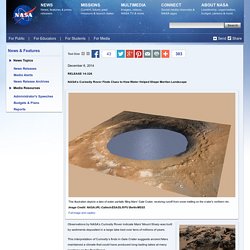

NASA’s Curiosity Rover Finds Clues to How Water Helped Shape Martian Landscape. This illustration depicts a lake of water partially filling Mars' Gale Crater, receiving runoff from snow melting on the crater's northern rim.

Image Credit: NASA/JPL-Caltech/ESA/DLR/FU Berlin/MSSS This evenly layered rock photographed by the Mast Camera (Mastcam) on NASA's Curiosity Mars Rover on Aug. 7, 2014, shows a pattern typical of a lake-floor sedimentary deposit not far from where flowing water entered a lake. This image from Curiosity's Mastcam shows inclined beds of sandstone interpreted as the deposits of small deltas fed by rivers flowing down from the Gale Crater rim and building out into a lake where Mount Sharp is now. It was taken March 13, 2014, just north of the "Kimberley" waypoint. This March 25, 2014, view from the Mastcam on NASA's Curiosity Mars rover looks southward at the Kimberley waypoint. This image shows an example of a thin-laminated, evenly stratified rock type that occurs in the "Pahrump Hills" outcrop at the base of Mount Sharp on Mars. And -end- Image Credit:
Curiosity Rover Data Indicates Gale Crater Mountain Used to be a Lake. This evenly layered rock photographed by the Mast Camera (Mastcam) on NASA’s Curiosity Mars Rover on Aug. 7, 2014, shows a pattern typical of a lake-floor sedimentary deposit not far from where flowing water entered a lake.

Credit: NASA/JPL-Caltech/MSSS. What is now a mountain, was once a lake. That’s the conclusion of the Curiosity Mars rover science team after studying data and imagery from the rover, which indicates that the mountain the rover is now climbing in Gale Crater – Aeolis Mons, or Mount Sharp — was built by sediments deposited in a large lake bed over tens of millions of years. “Gale Crater had a large lake at the bottom — perhaps even a series of lakes,” said Michael Meyer, lead scientist for NASA’s Mars Exploration Program during a press briefing on Monday, “that may have been big enough to last millions of years.” This diagram depicts rivers feeding into a lake. Further reading: NASAAdditional graphics from the press briefing.
Curiosity Rover Report: The Making of Mount Sharp (Dec. 8, 2014) Hello From Mars! Curiosity's Latest "Selfie" Mars Curiosity Descent - Ultra HD 30fps Smooth-Motion. Curiosity Rover raw image browser. Curiosity Rover Finds Biologically Useful Nitrogen on Mars. A team using the Sample Analysis at Mars (SAM) instrument suite aboard NASA's Curiosity rover has made the first detection of nitrogen on the surface of Mars from release during heating of Martian sediments.

The nitrogen was detected in the form of nitric oxide, and could be released from the breakdown of nitrates during heating. Nitrates are a class of molecules that contain nitrogen in a form that can be used by living organisms. The discovery adds to the evidence that ancient Mars was habitable for life. Nitrogen is essential for all known forms of life, since it is used in the building blocks of larger molecules like DNA and RNA, which encode the genetic instructions for life, and proteins, which are used to build structures like hair and nails, and to speed up or regulate chemical reactions.
However, on Earth and Mars, atmospheric nitrogen is locked up as nitrogen gas (N2) - two atoms of nitrogen bound together so strongly that they do not react easily with other molecules. And. Curiosity finds life-forming nitrogen on Mars. Published time: March 24, 2015 13:44 Curiosity.

(Reuters / NASA) Mars has given us new clues about the possibilities of past life on the planet after NASA’s Curiosity rover found nitrates embedded in its rock. The elements are known on Earth as one of the key precursors to life. Scientists have long searched for organic carbon molecules, which are still the number one candidate for proof of life, as they are produced by living organisms here on Earth. "People want to follow the carbon, but in many ways nitrogen is just as important a nutrient for life," Stern told the LA Times. READ MORE: Mars once had an ocean with more water than the Arctic – NASA The Monday study, published in the journal Proceedings of the National Academy of Sciences, talks of Mars harboring a special form of nitrogen conducive to microbial life, if any existed. Nitrogen also makes up the nucleobases that later form DNA and RNA.
READ MORE: Dry ice on Mars may help colonize red planet, research says.